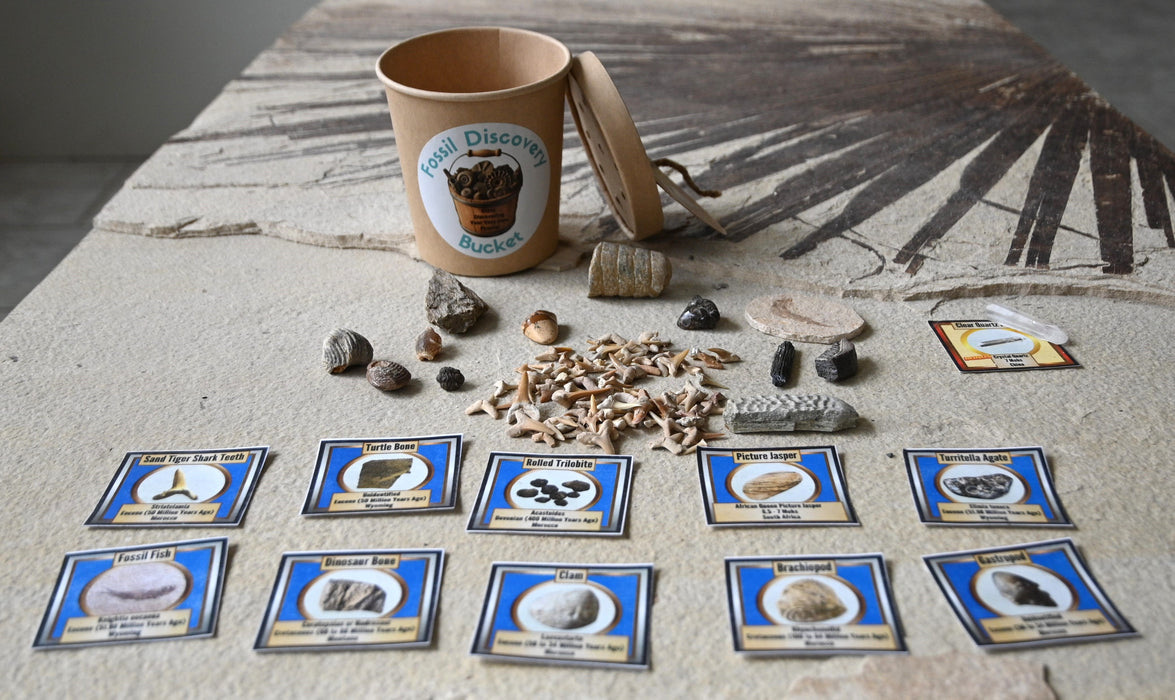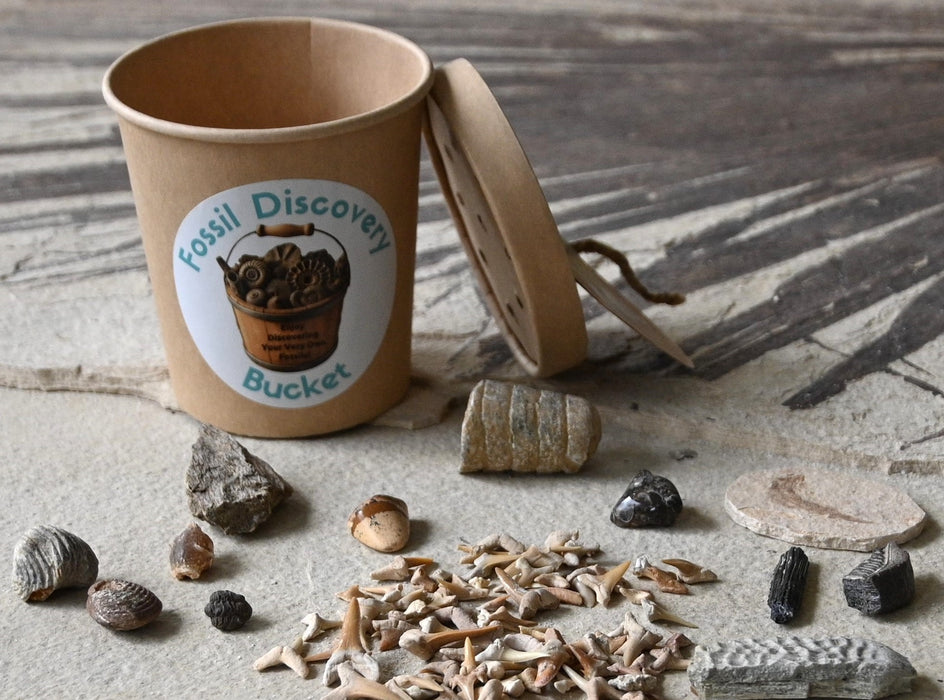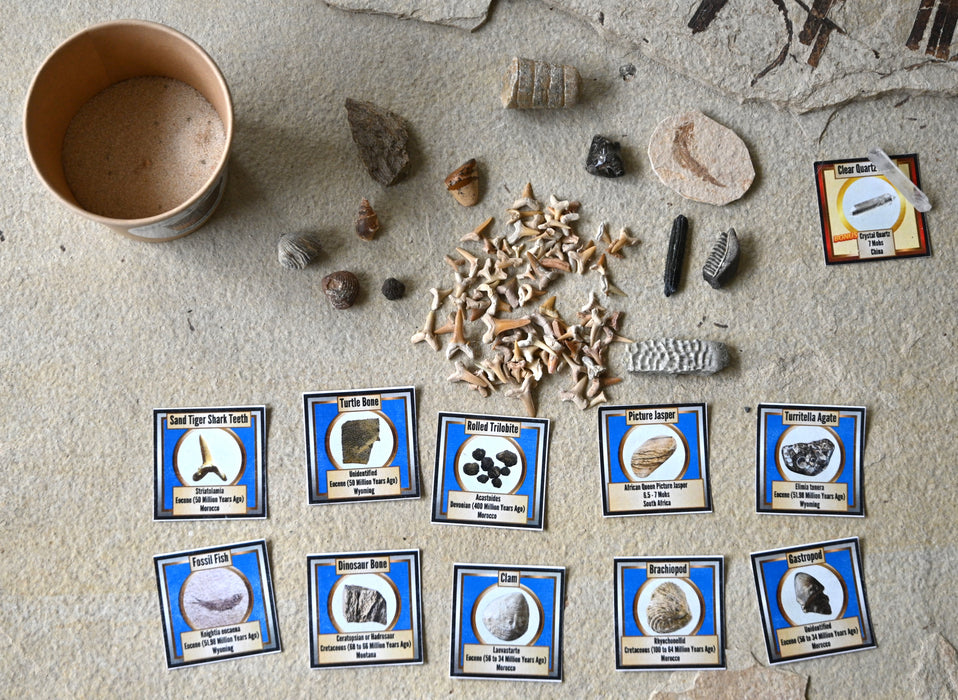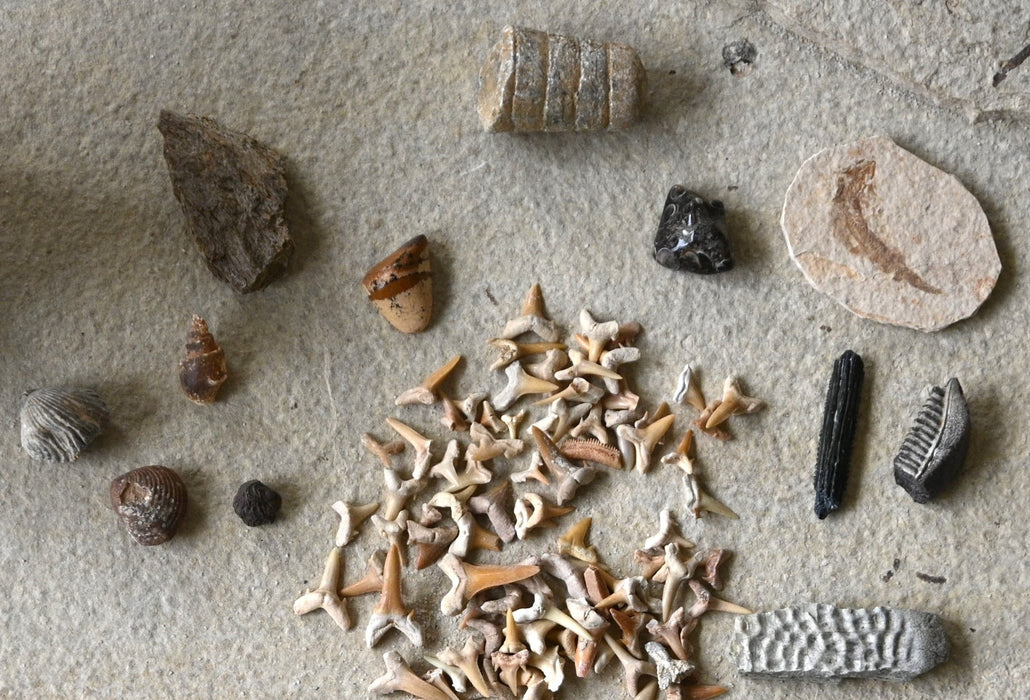
Mini Fossil Discovery Bucket
Dig into history with our Mini Fossil Discovery Bucket, a hands-on experience for fossil enthusiasts of all ages! Each 16 oz. bucket is packed with authentic, real fossils waiting to be uncovered. From ancient shark teeth and ammonites to fossilized shells and trilobites, every scoop holds a piece of prehistoric life.
🔎 What’s Inside?
✔ A variety of real fossils from different time periods
✔ Identification cards to help you learn about your finds
✔ Tools to assist in your fossil-hunting adventure
Perfect for kids, collectors, and anyone who loves the thrill of discovery! Whether you're starting a new hobby or adding to your collection, the Mini Fossil Discovery Bucket guarantees a fun and educational experience.
You will receive (All hand selected items. Items may vary from photos):
- 1 oz. of Sand Tiger Shark teeth
- One Brachiopod
- One Bivalve Clam Shell
- One Fossil Gastropod Shell
- One Orthocone
- One piece of Stingray Barb
- One piece of Stingray teeth (Crushing Plate)
- One piece of Bridger Formation Turtle Bone
- One piece of Dinosaur Bone
- One Green River Formation Knightia eocaena fossil fish
- One piece of tumbled Picture Jasper
- One piece of tumbled Turritella Agate
- One Acastoides Trilobite
Sand Tiger Shark Teeth
Species: Striatolamia sp. • Geological Age: Eocene (50 million years ago) • Location: Khouribga Province, Morocco
Striatolamia is an extinct genus of sharks belonging to the family Odontaspididae. These extinct sharks lived from the Early Paleocene to Late Miocene (61.7 to 10.3 Ma). The Latin genus name Striatolamia refers to the striations on the surface of the teeth. Striatolamia species could reach a length of about 3.5 meters.
Brachiopod
Species: Rhynchonellid sp. • Geological Age: Cretaceous (100 to 64 million years ago) • Location: Boujdour, Morocco
Bivalve Clam
Species: Laevastarte sp. • Geological Age: Eocene (56 to 33.9 million years ago) • Location: The Ouled Abdoun Basin, also known as Khouribga Basin, Khouribga, Morocco
Gastropod
Species: Unidentified • Geological Age: Eocene (56 to 33.9 million years ago) • Location: Morocco
Orthocone
Species: Orthoceras sp. • Geological Age: Devonian (400 million years ago) • Location: Morocco
Orthocone cephalopods also commonly identified as Orthoceras sp. are an extinct cephalopod that used jet propulsion to swim and hunt the seas for food. They are characterized by long, straight, conical shells that protect the siphuncle. The siphuncle is a tube that runs the entire length of the shell, through each of the chambers. This tube had two functions. Once filled with water, the cephalopod could force the water out, propelling itself backward with a kind of jet propulsion. Their closest living relatives are modern squid, cuttlefish, octopus, and nautilus.
Stingray Barbs and Crushing Plates
Species: Myliobatiformes • Geological Age: Miocene (15 to 2.6 million years ago) • Location: Florida
Myliobatiformes are one of the four orders of batoids, cartilaginous fish related to sharks. This order includes modern stingrays, eagle rays, manta rays, and their extinct relatives. Like other batoids, Myliobatiformes have a flattened body shape with enlarged pectoral fins, forming a broad disc. Rather than true bone, their skeletons were composed of cartilage, which is rarely fossilized except for mineralized portions like teeth, dermal denticles, and occasionally vertebrae. Many species developed a long, slender tail with one or more venomous barbed spines used for defense. Additionally, many developed flat dentition suited for crushing hard-shelled prey like mollusks and crustaceans.
Turtle Bone
Species: Unidentified • Geological Age: Eocene (50.3 to 46.2 million years ago) • Location: Bridger Formation, Wyoming
Dinosaur Bone
Species: Ceratopsian or Hadrosaur • Geological Age: Cretaceous (68 to 66 million years ago) • Location: Hell Creek Formation, Montana
The Hell Creek Formation was home to many diverse dinosaurs, including two major herbivore groups - ceratopsians and hadrosaurs. The most famous ceratopsian of Hell Creek is Triceratops. This large, quadrupedal dinosaur had a massive frill, three facial horns, and a robust beak for cropping tough vegetation. The most prominent hadrosaur of Hell Creek is Edmontosaurus, a large, "duck-billed dinosaur" with a long, low skull and a broad, tooth-packed jaw for grinding plant material. It was a facultative biped, meaning it could walk on both two and four legs. Ceratopsians and hadrosaurs both may have lived in herds or groups, with ceratopsians living in smaller herds and hadrosaurs in larger ones.
Fossil Fish
Species: Knightia eocaena • Geological Age: Eocene (51.98 million years ago) • Location: Green River Formation, Wyoming
Knightia eocaena fossil found from our private quarry. Knightia is an extinct genus of clupeid bony fish that lived in the freshwater lakes and rivers of North America and Asia during the Eocene epoch. It is the state fossil of Wyoming, and the most commonly excavated fossil fish in the world. Knightia belongs to the same taxonomic family as herring and sardines, and resembled the former closely enough that both Knightia alta and Knightia eocaena were originally described as species of true herring in the genus Clupea. As with modern-day clupeids, Knightia likely fed on algae and diatoms, as well as insects and occasionally smaller fish. A small schooling fish, Knightia made an abundant food source for larger Eocene predators. The Green River Formation has yielded many fossils of larger fish species preying on Knightia.
Picture Jasper is a variety of jasper that is characterized by patterning reminiscent of a scenic painting. Traditionally, this jasper has inclusions that produce a layered pattern that creates the illusion of a landscape. The landscapes are a result of deposition banding during formation. These layers are influenced by water flow and wind, in addition to coloring and dendritic patterning dictated by the composition of the inclusions. Picture jasper is a favorite of lapidarists because the material is easily cut, polished, shaped and is exciting throughout, meaning there is little waste.
Turritella Agate
Species: Elimia tenera • Geological Age: Eocene (51.98 million years ago) • Location: Wyoming
These stones are actually composed of agatized gastropod (snail) fossils from Wyoming. These fossils are Eocene in age or approximately 51.98 million years old. Technically, Turritella refers to the saltwater variety of snail. Elimia tenera is the proper name for this freshwater snail, but the name Turritella just stuck.
Rolled Trilobite
Species: Acastoides sp. • Geological Age: Devonian (400 million years ago) • Location: Morocco
These are tiny Acastoides trilobites from Morocco. Trilobites instinctively enrolled themselves in a defensive posture, resulting in them frequently being found preserved in this position. Trilobites, exclusively marine animals, first appeared at the beginning of the Cambrian Period, about 542 million years ago, when they dominated the seas. Although they became less abundant in succeeding geologic periods, a few forms persisted into the Permian Period, which ended about 251 million years ago.
WARNING: CHOKING HAZARD. SMALL PARTS.
CAUTION: SHARP OBJECTS INSIDE.
ADULT SUPERVISION IS RECOMMENDED.
NOT FOR CHILDREN UNDER 3 YEARS OLD.



